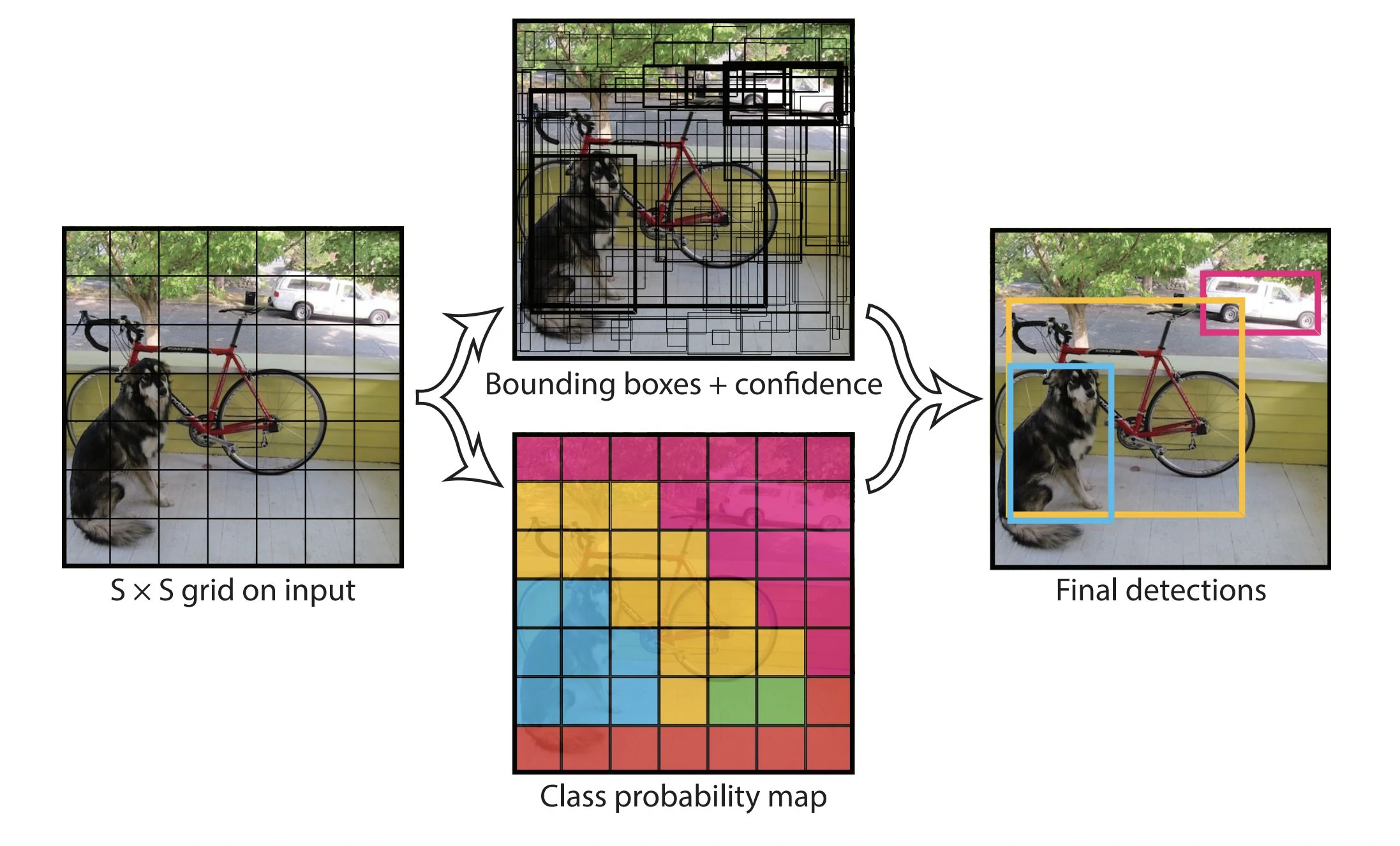12. 使用 OpenCV 进行深度学习
本章我们将使用 OpenCV 的深度学习接口,并将其用于目标检测和人脸检测。
本章介绍以下主题:
12.1 技术要求
12.2 深度学习简介
学习提示
如果需要了解,只靠本节的内容不足以了解,所以这里没有这部分笔记,建议有深度学习基础再阅读本章。
12.3 OpenCV 中的深度学习
深度学习模块在 3.1 作为贡献模块引入,并成为 3.3 版本的一部分。但直到 3.4.3+ 和 4.x 版本才被广泛使用。
OpenCV 不支持反向传播,这意味 OpenCV 只能使用训练好的网络进行前向推理。这是因为 OpenCV 没有必要实现别人(PyTorch、TensorFlow 等)擅长的东西,OpenCV 更适合部署,因此应该专注于优化推理的计算速度。
你可以从头开始创建网络,也可以使用现有的网络。有一些网站(例如 TensorEditor(已失效) 和 lobe.ai)能够从可视化的设计器中生成代码来方便我们进行训练。
当我们得到一个令人满意的神经网络,我们就可以把网络的结构和参数导入到 OpenCV 中进行推理啦。
12.4 YOLO 用于实时对象检测
YOLO 是目前最快的对象检测和识别算法之一,NVIDIA Titan X 上可以达到 30 fps(YOLOv3)。
YOLOv7 是更好的选择
当前(2022 年 11 月 11 日)YOLOv7 比以前的版本更快也更加精确,后面也将 YOLOv7 的 OpenCV 部署发布出来。
12.4.1 YOLOv3 深度学习模型架构
YOLO 把整张图像划分成 大小的网络,对于每个网格,YOLO 网络模型预测 个边界框,然后得出边界框包含可能对象的置信度。

预测框
在上面的例子中,图片被分成了 49 个框,每个框预测 2 个预测框(bounding box),因此上面的图中有 98 个预测框。
可以看到这些预测框中有的边框比较粗,有的比较细,这是置信度不同的表现,置信度高的比较粗,置信度低的比较细。
每个预测框有 5 个量,即中心位置()、宽高()和置信度。
输出结果的总数应该是:
YOLO 默认使用 80 个类别 个网格,5 个分量即预测框的 5 个量,类别数使用 表示,即 ,这里的类别用 One-Hot 编码表示,总数为:
排列方式是:
YOLOv3 架构基于 DarkNet,DarkNet 包含 53 个网络层,YOLOv3 增加了 53 个 层,所以它有 106 层。如果需要更小更快,可以参考 TinyYOLO 或其他迷你版本。
12.4.2 YOLO 数据集、词汇表和模型
YOLO 使用 COCO 数据集,COCO 数据集包含 80 个类别。
下载文件:
- 模型文件:
https://pjreddie.com/media/files/yolov3.weights - 网络文件:
https://github.com/pjreddie/darknet/blob/master/cfg/yolov3.cfg - 词汇表:
https://github.com/pjreddie/darknet/blob/master/data/coco.names
将 yolov3.weights、yolov3.cfg 和 coco.names 放置在本项目的根目录。
12.4.3 将 YOLO 导入 OpenCV
深度学习模块需要使用命名空间 cv::dnn,引入 <opencv2/dnn.hpp>。
OpenCV 的 Mat 图像需要转换为 DNN 张量 / Blob 格式才能输入到神经网络中,可以使用 cv::dnn::blobFromImage() 函数进行转换。
cv::dnn::blobFromImage() 函数的声明如下:
void blobFromImage(
InputArray image,
OutputArray blob,
double scalefactor=1.0,
const Size& size = Size(),
const Scalar& mean = Scalar(),
bool swapRB=false,
bool crop=false,
int ddepth=CV_32F
);
Mat blobFromImage(
InputArray image,
double scalefactor=1.0,
const Size& size = Size(),
const Scalar& mean = Scalar(),
bool swapRB=false,
bool crop=false,
int ddepth=CV_32F
);
其参数如下:
image:输入图像(可能是 1、3 或 4 通道)blob:输出Mat对象scalefactor:图像值乘数size:mean:swapRB:交换颜色通道crop:是否裁剪ddepth:
我们的代码大致如下,其中的后处理和获取输出名称的函数并未进行实现,完整的实现可以参考本章的代码仓库。
#include <fstream>
#include <iostream>
#include <sstream>
#include <opencv2/core.hpp>
#include <opencv2/dnn.hpp>
#include <opencv2/highgui.hpp>
#include <opencv2/imgproc.hpp>
constexpr float CONFIDENCE_THRESHOLD = 0.5;
constexpr float NMS_THRESHOLD = 0.4;
constexpr int INPUT_WIDTH = 416;
constexpr int INPUT_HEIGHT = 416;
std::vector<std::string> classes;
std::vector<std::string> getOutputsNames(const cv::dnn::Net& net) {
}
void postprocess(cv::Mat& frame, const std::vector<cv::Mat>& outs) {
}
int main(int argc, char* argv[]) {
if (argc < 2) {
std::cout << "Usage: " << argv[0] << " <image>" << std::endl;
return -1;
}
std::string classesFile = "coco.names";
std::ifstream ifs(classesFile.c_str());
std::string line;
while (std::getline(ifs, line))
classes.push_back(line);
std::string modelConfiguration = "yolov3.cfg";
std::string modelWeights = "yolov3.weights";
cv::dnn::Net net = cv::dnn::readNetFromDarknet(modelConfiguration, modelWeights);
net.setPreferableBackend(cv::dnn::DNN_BACKEND_OPENCV);
net.setPreferableTarget(cv::dnn::DNN_TARGET_CPU);
cv::Mat input, blob;
input = cv::imread(argv[1]);
if (input.empty()) {
std::cout << "Could not read the image: " << argv[1] << std::endl;
return -1;
}
cv::dnn::blobFromImage(input, blob, 1 / 255.f, cv::Size(INPUT_WIDTH, INPUT_HEIGHT), cv::Scalar(0, 0, 0), true, false);
net.setInput(blob);
std::vector<cv::Mat> outs;
net.forward(outs, getOutputsNames(net));
postprocess(input, outs);
#ifndef Profile
std::vector<double> layersTimes;
double freq = cv::getTickFrequency() / 1000;
double t = net.getPerfProfile(layersTimes) / freq;
std::string label = cv::format("Inference time for a frame : %.2f ms", t);
std::cout << label << std::endl;
#endif
cv::imshow("object detection", input);
cv::waitKey();
return 0;
}
12.5 使用 SSD 进行人脸检测
单摄检测(Single Shot Detection,SSD)是另一种快速、准确的深度学习对象检测方法,它具有和 YOLO 类似的概念,可以在同一架构预测对象和边界框。
12.5.1 SSD 模型架构
12.5.2 将 SSD 人脸检测导入 OpenCV
本文的 SSD 模型使用 Caffe 格式,需要 OpenCV 使用 cv::dnn::readNetFromCaffe() 来创建网络。
#include <iostream>
#include <opencv2/dnn.hpp>
#include <opencv2/highgui.hpp>
#include <opencv2/imgproc.hpp>
using namespace cv;
using namespace std;
using namespace cv::dnn;
const size_t inWidth = 300;
const size_t inHeight = 300;
const double inScaleFactor = 1.0;
const Scalar meanVal(104.0, 177.0, 123.0);
const char* about =
"This sample uses Single-Shot Detector "
"(https://arxiv.org/abs/1512.02325) "
"with ResNet-10 architecture to detect faces on camera/video/image.\n"
"More information about the training is available here: "
"<OPENCV_SRC_DIR>/samples/dnn/face_detector/"
"how_to_train_face_detector.txt\n"
".caffemodel model's file is available here: "
"<OPENCV_SRC_DIR>/samples/dnn/face_detector/"
"res10_300x300_ssd_iter_140000.caffemodel\n"
".prototxt file is available here: "
"<OPENCV_SRC_DIR>/samples/dnn/face_detector/deploy.prototxt\n";
const char* params =
"{ help | false | print usage }"
"{ proto | | model configuration (deploy.prototxt) }"
"{ model | | model weights "
"(res10_300x300_ssd_iter_140000.caffemodel) }"
"{ camera_device | 0 | camera device number }"
"{ video | | video or image for detection }"
"{ opencl | false | enable OpenCL }"
"{ min_confidence | 0.5 | min confidence }";
int main(int argc, char** argv) {
CommandLineParser parser(argc, argv, params);
if (parser.get<bool>("help")) {
cout << about << endl;
parser.printMessage();
return 0;
}
String modelConfiguration = parser.get<string>("proto");
String modelBinary = parser.get<string>("model");
//! [Initialize network]
dnn::Net net = readNetFromCaffe(modelConfiguration, modelBinary);
//! [Initialize network]
if (net.empty()) {
cerr << "Can't load network by using the following files: " << endl;
cerr << "prototxt: " << modelConfiguration << endl;
cerr << "caffemodel: " << modelBinary << endl;
cerr << "Models are available here:" << endl;
cerr << "<OPENCV_SRC_DIR>/samples/dnn/face_detector" << endl;
cerr << "or here:" << endl;
cerr << "https://github.com/opencv/opencv/tree/master/samples/dnn/"
"face_detector"
<< endl;
exit(-1);
}
if (parser.get<bool>("opencl")) {
net.setPreferableTarget(DNN_TARGET_OPENCL);
}
VideoCapture cap;
if (parser.get<String>("video").empty()) {
int cameraDevice = parser.get<int>("camera_device");
cap = VideoCapture(cameraDevice);
if (!cap.isOpened()) {
cout << "Couldn't find camera: " << cameraDevice << endl;
return -1;
}
} else {
cap.open(parser.get<String>("video"));
if (!cap.isOpened()) {
cout << "Couldn't open image or video: "
<< parser.get<String>("video") << endl;
return -1;
}
}
for (;;) {
Mat frame;
cap >> frame; // get a new frame from camera/video or read image
if (frame.empty()) {
waitKey();
break;
}
if (frame.channels() == 4) cvtColor(frame, frame, COLOR_BGRA2BGR);
//! [Prepare blob]
Mat inputBlob = blobFromImage(frame, inScaleFactor,
Size(inWidth, inHeight), meanVal, false,
false); // Convert Mat to batch of images
//! [Prepare blob]
//! [Set input blob]
net.setInput(inputBlob, "data"); // set the network input
//! [Set input blob]
//! [Make forward pass]
Mat detection = net.forward("detection_out"); // compute output
//! [Make forward pass]
vector<double> layersTimings;
double freq = getTickFrequency() / 1000;
double time = net.getPerfProfile(layersTimings) / freq;
Mat detectionMat(detection.size[2], detection.size[3], CV_32F,
detection.ptr<float>());
ostringstream ss;
ss << "FPS: " << 1000 / time << " ; time: " << time << " ms";
putText(frame, ss.str(), Point(20, 20), 0, 0.5, Scalar(0, 0, 255));
float confidenceThreshold = parser.get<float>("min_confidence");
for (int i = 0; i < detectionMat.rows; i++) {
float confidence = detectionMat.at<float>(i, 2);
if (confidence > confidenceThreshold) {
int xLeftBottom =
static_cast<int>(detectionMat.at<float>(i, 3) * frame.cols);
int yLeftBottom =
static_cast<int>(detectionMat.at<float>(i, 4) * frame.rows);
int xRightTop =
static_cast<int>(detectionMat.at<float>(i, 5) * frame.cols);
int yRightTop =
static_cast<int>(detectionMat.at<float>(i, 6) * frame.rows);
Rect object((int)xLeftBottom, (int)yLeftBottom,
(int)(xRightTop - xLeftBottom),
(int)(yRightTop - yLeftBottom));
rectangle(frame, object, Scalar(0, 255, 0));
ss.str("");
ss << confidence;
String conf(ss.str());
String label = "Face: " + conf;
int baseLine = 0;
Size labelSize =
getTextSize(label, FONT_HERSHEY_SIMPLEX, 0.5, 1, &baseLine);
rectangle(
frame,
Rect(Point(xLeftBottom, yLeftBottom - labelSize.height),
Size(labelSize.width, labelSize.height + baseLine)),
Scalar(255, 255, 255), FILLED);
putText(frame, label, Point(xLeftBottom, yLeftBottom),
FONT_HERSHEY_SIMPLEX, 0.5, Scalar(0, 0, 0));
}
}
imshow("detections", frame);
if (waitKey(1) >= 0) break;
}
return 0;
}